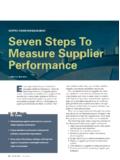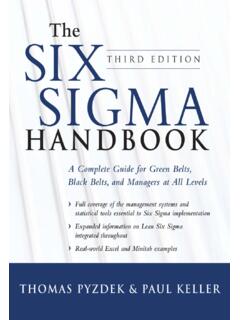Transcription of The Daily Production Meeting Doing It Lean!
1 The Daily Production Meeting Doing It lean ! J. E. Boyer Company, Inc. John E. Boyer, President Copyright 2004 by J. E. Boyer Company, Inc. No portion of this article may be reproduced in whole or in part without the prior written permission of J. E. Boyer Company, Inc. Written materials and intellectual property are protected by United States copyright, trademark, and patent laws. J. E. Boyer Company offers no specific guarantees of the practices presented, but the professionals at J. E. Boyer Company make every reasonable effort to present reliable and fact-based information. The Daily Production Meeting Doing It lean ! 2004 J. E.
2 Boyer Company, Inc. 2 The Daily Production Meeting - Doing It lean ! by John E. Boyer, President, J. E. Boyer Company, Inc. Introduction Nearly every manufacturing company has a Daily or weekly Production Meeting . It is where many Production , customer, materials, personnel, and other issues are addressed. Any number of people attend .. some because they must, some to gather information, and some to provide information. Having attended hundreds of these Meeting over the years in dozens of companies from many types of industries, it is my experience that these meetings are held in an astonishingly wide variety of ways. Some are very effective .. some are not. Some are full of fact-based information.
3 Others are opinion oriented gripe sessions. Some help sort out the tough issues of the day .. in others only 'good news' is permitted. Visualize your Daily Production Meeting . Are the right people there? Is the agenda crisp and clear? Are the right issues addressed? Are attendees prepared and accountable? Is information in a one-source fit-for-use condition? Is performance reported, measured, visually charted, and used to effectively drive improvement? In a lean manufacturing environment where Daily planning and execution are critical, this Meeting plays a key role in cost control and on-time performance. The objective of this presentation is to help you answer "YES" to these questions!
4 This presentation will be conducted in a rather unusual way. My plan is to "script" a typical poorly conducted Daily Production Meeting and have some random members from the audience conduct the Meeting . This will take about 10 minutes. Following this skit, we will determine what was right and what was wrong, and discuss the characteristics of how the Meeting should be done. Our participants will then conduct a high performance Daily Production Meeting . You will see a HUGE difference. Once you've seen it, you can go back to your company and do it! Daily Production Meeting Definition and Objectives The Daily Production Meeting (DPM) is a 15-30 minute get-together of key/appropriate people to assess, measure, communicate and plan Production schedules.
5 The objectives of the Meeting are to: Assess rate and schedule performance from the previous day Confirm the schedule for the current day Set the schedule for the next day or two Discuss, report, and resolve Production and customer issues Maintain valid Production dates on all Production schedules (or work orders) and customer orders for use by materials and customer service The Daily Production Meeting Doing It lean ! 2004 J. E. Boyer Company, Inc. 3 Special Importance of the DPM in a lean Manufacturing Environment In a lean manufacturing environment, a normal practice is to have Rate-Based Due-Date-Driven Production in place. The factory will be organized into a number of cells and/or Production flow lines.
6 Each of these cells/lines will have an established Daily run rate or rate of output in terms of units, earned hours, equivalent units, and/or dollars. These run rates are by month through an appropriate planning horizon (at least six months) and are updated monthly. These run rates are determined in the Sales and Operations Planning process. For example: Cell Run Rate Large Gizmos 1,000 equivalent units/day Small Gizmos 5,000 units/day Special Gizmos 200 earned hours/day In addition to the run rate, there is a schedule for each cell/line consisting of a number of end items that will be complete each day. It includes items going directly to customers and items going to the distribution system (finished goods).
7 In other words the cell/lines are due date driven. It doesn t matter how the schedule is created (MRP, Kanban signals, other visual methods, other take action reports), there is still a statement of the work that must be completed each day. Assuming that your lean operation incorporates Rate-Based and Due-Date-Driven Production , as it should, the DPM becomes especially important as the formal and regular activity for measuring, fine tuning, and communicating the Daily schedule. Dates In the DPM it is crucial that dates are maintained and kept valid. This goes for schedule (work order) dates and customer order dates. This is a simple principle, but most companies overlook it.
8 Here is an example. A customer order has a due date of 10-13-04. However, this date passes and the order does not ship. It is now 10-14-04. The truth is that the due date on the order has changed. It can not be shipped in the past. The only outstanding question is whether to formally deal with it or not. By formally deal with it, I mean change/update the date in the business system. Imagine a customer service person getting a call on 10-14-04 from the customer asking when the order will ship. The person puts the order on their screen and the due date says 10-13-04. In this case of looking at an invalid date, the best the person can do is try to chase the order on the sneaker net and get back to the customer.
9 However, if the date was maintained and valid, the customer could be answered right away. To implement date validity, three date concepts must be understood: 1. Customer Request this is the date that the customer asked for the shipment to be made. As unrealistic as it may be, it is what the customer wants. It never changes unless initialed by the customer. The Daily Production Meeting Doing It lean ! 2004 J. E. Boyer Company, Inc. 4 2. Original Promise this is the due date that the company gave to the customer at the time of order entry. It never changes unless repromised based on a customer request. 3. Current Promise this is the system positioner due date and is the current best estimate of what is going to happen.
10 This is the due date that MUST be kept valid Daily . It is NEVER past due. You can t ship something yesterday. The same logic holds true for schedule (work order) dates. However quite often only two dates are used: 1. Original Schedule this is the due date that the schedule was originally given at the time the schedule was first established. 2. Current Schedule this is the system positioner due date and is the current best estimate of what is going to happen. This is the due date that MUST be kept valid Daily . It is NEVER past due. You can t produce something yesterday. Date validity is a wonderful practice to have. Valid dates basically enables the business system to provide valid information.






